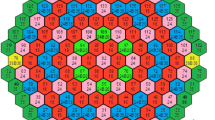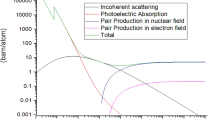Abstract
The radiation damage in the structural materials of a 500 MWe Indian prototype fast breeder reactor (PFBR) is re-assessed by computing the neutron displacement per atom (dpa) cross-sections from the recent nuclear data library evaluated by the USA, ENDF / B-VII.1, wherein revisions were taken place in the new evaluations of basic nuclear data because of using the state-of-the-art neutron cross-section experiments, nuclear model-based predictions and modern data evaluation techniques. An indigenous computer code, computation of radiation damage (CRaD), is developed at our centre to compute primary-knock-on atom (PKA) spectra and displacement cross-sections of materials both in point-wise and any chosen group structure from the evaluated nuclear data libraries. The new radiation damage model, athermal recombination-corrected displacement per atom (arc-dpa), developed based on molecular dynamics simulations is also incorporated in our study. This work is the result of our earlier initiatives to overcome some of the limitations experienced while using codes like RECOIL, SPECTER and NJOY 2016, to estimate radiation damage. Agreement of CRaD results with other codes and ASTM standard for Fe dpa cross-section is found good. The present estimate of total dpa in D-9 steel of PFBR necessitates renormalisation of experimental correlations of dpa and radiation damage to ensure consistency of damage prediction with ENDF / B-VII.1 library.













Similar content being viewed by others
References
F Seitz, Discuss. Faraday Soc. 5, 271 (1949)
W S Snyder and J Neufeld, Phys. Rev. 97, 1636 (1955)
F A Garner, Comprehens. Nucl. Mater. 4, 33 (2012)
L R Greenwood, J. Nucl. Mater. 216, 29 (1994)
Gary S Was, Fundamentals of radiation materials science (Springer, New York, 2007)
L I Ivanov and Yu M Platov, Radiation physics of metals and its applications (Cambridge International Science Publishing, 2004) pp. 5–11
M J Norgett, M T Robinson and I M Torrens, Nucl. Eng. Des. 33, 50 (1975)
M T Robinson and I M Torrens, Phys. Rev. B 9, 5008 (1974)
J Lindhard, V Nielsen, M Scharff and P V Thomsen, Mat. Fys. Medd. Dan. Vid. Selsk. 33(10) (1963)
J Lindhard, M Scharff and H E Schiøtt, Mat. Fys. Medd. Dan. Vid. Selsk. 33(14), 1 (1963)
G H Kinchin and R S Pease, Rep. Prog. Phys. 18(1), 1 (1955)
D J Bacon, F Gao and Yu N Osetsky, Nucl. Instrum. Methods 153, 87 (1999)
R S Averback, R Benedek and K L Merkle, Phys. Rev. B 18, 4156 (1978)
J H Kinney, M W Guinan and Z A Munir, J. Nucl. Mater. 122–123, 1028 (1984)
P Jung, J. Nucl. Mater. 117, 70 (1983)
Kai Nordlund et al, Primary radiation damage in materials, Report Nuclear Science NEA\(/\)NSC\(/\)DOC (2015) 9, OECD/NEA, 2015
R E Stoller, L R Greenwood and S P Simakov, Primary radiation damage cross sections, Report INDC (NDS)-0691 (IAEA Headquarters, Vienna, Austria, 2015)
T A Gabriel, J D Amburgey and N M Greene, Radiation damage calculations: Primary recoil spectra, displacement rates, and gas production rates, Report ORNL\(/\)TM-5160 (Oak Ridge National Laboratory, 1976)
L R Greenwood and R K Smither, SPECTER: Neutron damage calculations for materials irradiations, Report ANL\(/\)FPP\(/\)TM-197 (Argonne National Laboratory, 1985)
M B Chadwick et al, Nuclear Data Sheets 112, 2887 (2011)
A C Kahler, The NJOY nuclear data processing system, Version 2016, Report LA-UR-17-20093 (Los Alamos National Laboratory, 2016)
R S Averback and K L Merkle, Phys. Rev. B 16, 3860 (1977)
L Malerba, J. Nucl. Mater. 351, 28 (2006)
J D Jenkins, Nucl. Sci. Eng. 41, 155 (1970)
W Sheely, Nucl. Sci. Eng. 29, 165 (1967)
Uttiyoarnab Saha and K Devan, Proceedings of the DAE-BRNS Symp. on Nucl. Phys. (2016) Vol. 61, pp. 644–645
ASTM E693-12, Standard practice for charactersing neutron exposures in iron and low alloy steels in terms of displacements per atom (DPA), E 706 (ID)
P Puthiyavinayagam et al, Development of fast breeder reactor technology in India, progress in nuclear energy (2017), https://doi.org/10.1016/j.pnucene.2017.03.015
P Satyamurthy, L M Gantayet and A K Ray, Pramana – J. Phys. 68, 343 (2007)
S Ganesan, Pramana – J. Phys. 68, 257 (2007)
A Bouhaddane et al, J. Phys.: Conf. Ser. 516, 012024 (2014)
V Kumar, Harphool Kumawat and Manish Sharma, Pramana – J. Phys. 68, 315 (2007)
ENDF-6 Formats Manual, CSEWG Document ENDF-102, Report BNL-90365-2009 Rev.1
Junhyun Kwon, Yong Hee Choi and Gyeong-Geun Lee, 2nd Research coordination meeting on primary radiation damage cross-Section (Vienna, Austria, June 29–July 2, 2015)
Acknowledgements
The authors gratefully acknowledge Dr V Gopalakrishnan, former Head, Nuclear Data Section, Reactor Design Group, IGCAR, for his keen interest and the initiatives made for developing an Indian radiation damage code for fast reactor applications. His guidance and encouragement for this work are also acknowledged.
Author information
Authors and Affiliations
Corresponding author
Appendix A
Appendix A
1.1 Group averaging point dpa cross-section
The point dpa cross-section is group-averaged into a neutron group structure using eq. (A.1). This expression shows the total multigrouped dpa cross-section in the gth neutron group.
1.2 Reaction kinematics
The energy–cross-section data for different reactions i are given in different sections of file 3 of ENDF / B-VII.1 tape for the material. The kernel of energy transfer for each reaction depends on the kinematics of neutron–nucleus reaction. These are briefly given below [5, 18, 19, 21, 24, 34, 35].
1.2.1 Elastic and resolved level inelastic scattering
where Q is the Q-value for discrete inelastic scattering to take place from a particular level. \(\mu \) is the centre of mass cosine of angle of scattering of the neutron. The incident energy-secondary angular parameters, \(a_{l}(E)\) or the full summation in eq. (A.3) are given in file 4 section 2 for elastic scattering. For discrete inelastic scattering \(a_{l}(E)\) are given in sections 51–91 of either file 4 or file 6.
1.2.2 Continuum inelastic scattering and (n, 2n) reaction
The secondary particle energy distribution is either given in file 5 or file 6. File 6 may also contain the product energy-angle distribution and recoil energy distribution for these reactions. If the recoil energy distribution is available, then these data are used from the file. If such data are not available, evaporation model of nuclear reaction is adapted. In this model, the energy transfer kernel is given as follows:
A.2.2.1 Continuum inelastic scattering.
The maximum value of \(E'\) is
where \(Q_{l}\) is the Q-value for the lowest level. The distribution function \(f(E, E')\) represents the probability that a neutron of energy \(E'\) in the centre of mass frame is evaporated from the compound nucleus. In the centre of mass frame it is given as the Maxwellian of nuclear temperature \(E_{\mathrm{D}} = { kT}\):
where
is a normalization factor such that
A.2.2.2 (n, 2n) Reaction.
where I(E) is given by eq. (A.6) with \(E'^{\mathrm{max} }=E\) and \(I(E, E')\) is given by eq. (A.6) with \(E'^{\mathrm{max}}\) replaced by \(E''^{\mathrm{max} }=E\)–\(E'\).
The recoil energies in these two reactions can be found by
where \(\mu \) is the laboratory cosine of the angle of emission of secondary neutron.
1.2.3 Threshold n, particle reactions
File 6 of the ENDF / B-VII.1 tape for the material may contain the recoil energy distribution for these reactions in specific sections. These data are used when available. If such data are not available, then the recoil energy is found from the following equations:
where a is ratio of the emitted particle mass to neutron mass,
and energy of the emitted particle \(E_{\mathrm{p}}\) is approximately chosen as the smaller value between the available energy
and the Coulomb barrier energy
z and Z being charges of the emitted particle and the target respectively.
The energy transfer kernel in this case (considering isotropic emission of recoil atom) is
1.2.4 (n, \(\gamma \)) reaction
The average of \(E_{\gamma }^{2}\) is evaluated from the gamma yield data given in file 12 for discrete gamma and distribution given in file 15 for continuum gamma. The damage energy from this reaction is calculated from recoil energy considering isotropic gamma emission.
Rights and permissions
About this article
Cite this article
Saha, U., Devan, K., Bachchan, A. et al. Neutron radiation damage studies in the structural materials of a 500 MWe fast breeder reactor using DPA cross-sections from ENDF / B-VII.1. Pramana - J Phys 90, 46 (2018). https://doi.org/10.1007/s12043-018-1536-y
Received:
Revised:
Accepted:
Published:
DOI: https://doi.org/10.1007/s12043-018-1536-y
Keywords
- Primary-knock-on atom spectra
- displacement per atom
- displacement per atom cross-section
- computation of radiation damage
- molecular dynamics simulation
- renormalisation




